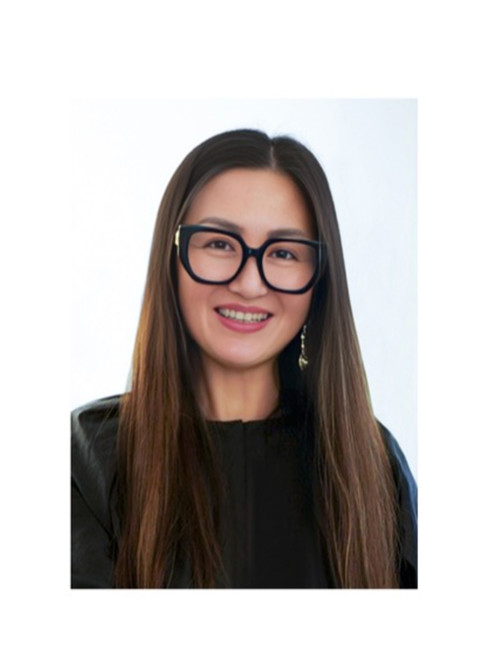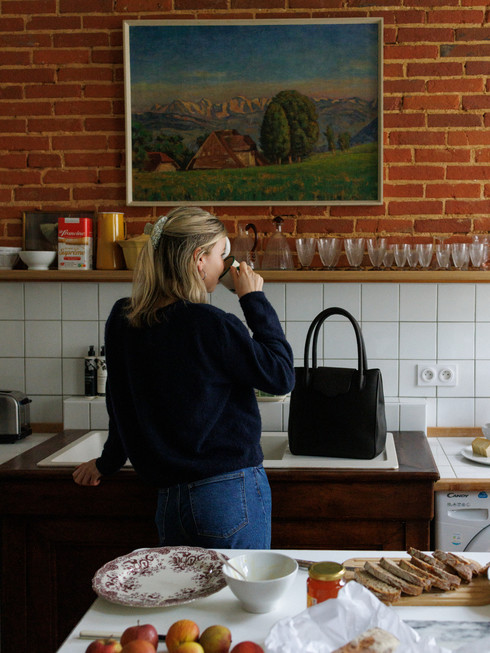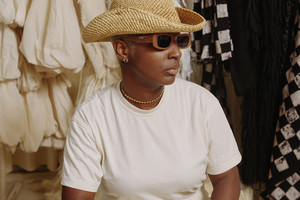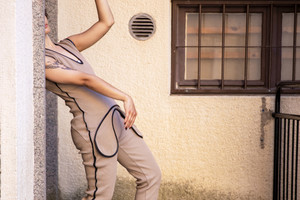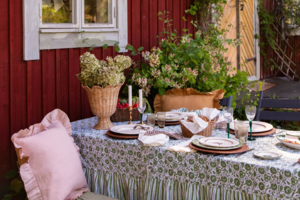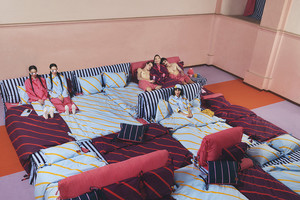Socker Sucker in central Stockholm has been a go-to destination for innovative and delicious pastries since opening its doors three years ago. Now, founders Frida Bäcke and Bedros Kabranian have collected a range of their recipes and step-by-step guides into a book, giving home bakers the tools to recreate their celebrated pastries at home. Odalisque sat down with the duo to talk about their inspirations and what they hope readers take away from the book.
UL: What was the driving force behind writing Socker Sucker? Was there a particular moment of realization that made you want to share these recipes in a book?
Bedros Kabranian: Not really, we got a great offer and it felt like there was space for it.
Frida Bäcke: Exactly, and it also felt like a beautiful way to sum up our careers. We've been working for a long time, and this feels like the next chapter, to wrap it all up in a book in a nice way because we don’t really know what’s coming next.
BK: Also, when this idea came up in the past, it didn’t feel like the right time. But now everything aligned, and it just felt right.
UL: Many of these recipes have a luxurious twist. Can you give us an example of a classic pastry that you’ve reimagined in a surprising way?
BK: Everything from the cinnamon bun, really, we changed the shape just to break the norm. It's super simple but just changing the form makes it into something else.
FB: And the Napoleon is another classic that’s always been done a certain way, and that we’ve also reworked. It really represents both of us with its lamination, filling, and flavour. It’s definitely one of those classics we’ve reinvented. But we’ve also taken flavour inspiration from the classics.
BK: We've said before that we break a classic down into its different flavour elements, and then rebuild it. A lot of our work comes from that approach. Everything, I’d say, is in some way reinterpreted from a classic.
UL: You draw inspiration from global influences. Which international flavours or techniques have influenced your recipes the most?
BK: For me, it’s the Middle East. That’s where my foundational palette is, along with the rest of the world. For you (Frida), it’s the forest and your childhood in Dalarna, picking things yourself, spruce tips, berries…
FB: Yes, exactly. It becomes more of a blend between the two of us, and that makes it special in a way. Also, during the pandemic when we couldn’t travel, we pulled in flavours from other parts of the world. But we really work with ingredients when they’re at their seasonal best, wherever they happen to come from.
UL: The book covers baked goods for every season, from Semlor to Christmas saffron buns. How did you approach balancing tradition with innovation in these beloved recipes?
BK: It actually wasn’t too hard. We set some boundaries for ourselves so we wouldn’t stray too far. And once we were in it, it was about small adjustments like swapping raisins for cranberries. Not just for the sake of it, but because we think it adds a different effect and taste. We kept the Semla pretty classic, it’s a classic, after all.
FB: It’s the little things we do, like toasting and refining ingredients in the best way.
BK: Yes, instead of regular sugar you might use a different kind. Or instead of butter, browned butter. Seeds and flours can be toasted. It’s those kinds of things.
FB: It feels more thoughtful. Considering today’s ingredient shortages, it seems like a shame to waste good ingredients. We want to really care for what we have.
BK: We’re always respecting the original. We're not butchering The Classic, we’re elevating it. And sometimes adding a flavour twist or a visual twist.
UL: Step-by-step guides are a key feature of Socker Sucker. Which techniques do you think home bakers will find most useful or most challenging?
BK: Lining a tart shell. I think that’s something many struggle with.
FB: Exactly, you cut it into strips and stamp it out.
BK: And just having someone show you, that’ll be an aha moment for many.
FB: Yes, like not pressing it all the way down.
BK: Right, because you’ve done that your whole life. And then it cracks and looks bad. Just thinking a bit differently makes a huge difference. And chocolate lamination, of course.
FB: Yes, chocolate lamination. We actually put the hardest ones at the beginning of the book to try and show them clearly.
BK: There’s already a lot out there, but showing readers that we ourselves do it this way and get these results, I think that matters.
UL: Your professional backgrounds and competition experience clearly show in your expertise. Are there any secrets or pro tips in the book that most home bakers wouldn’t usually have access to?
FB: Oh, I feel like the whole book is full of that kind of candy, really.
BK: Right at the beginning, we’ve got a section with tips on everything from liquids to temperatures, and how to think about small details. But each individual recipe also has tips that are second nature to us but might be crucial. Everything from proofing to contact loading.
When I started working in the industry, so many times I had those “aha” moments, like, “of course, why didn’t I do it this way before?” Because you’re stuck in your habits. I think just seeing a different way opens up your thinking.
FB: Exactly. And we’re still learning those things all the time. That’s why this profession is so fun. You keep discovering things. This book represents how far we’ve come now—and there will be more.
BK: Volume one.
UL: Precision and perfection seem to be hallmarks of Socker Sucker’s baking. What small details make a big difference in achieving bakery-quality results at home?
FB: Read everything through first, have a plan. Don’t decide to make an entire cake in one day, plan it out. Maybe make the fillings and interiors on Tuesday, the sponge on Wednesday, assemble on Thursday, and glaze it on Friday. Planning your bake makes it much more enjoyable, instead of cramming it all into one day.
BK: With buns and things like that, make a sugar syrup and follow the recipe. It’s not always obvious where to brush with egg wash. Don’t overdo it unnecessarily. Some people use both egg wash and sugar syrup, it becomes redundant.
UL: For someone attempting one of your more advanced pastries like mille-feuille or croissants, what advice would you give to ensure success?
BK: Start smaller. That way, you stay in control of the dough and butter. Clear out space in your fridge and freezer so you can pop the dough in and out. It’s hard to say “go by feel,” but if something gets too soft or warm just get it back in the fridge. Take it out 10–15–20 minutes later when it's manageable. Also, butter warmer than dough is preferred. That way the dough affects the butter, giving you a larger window to work in than when everything is at perfect temperature which actually makes it harder.
UL: If a reader could try just one recipe from the book first, which one would you recommend and why?
FB: I’d probably go for the Hallongrotta or Hasselnötsdrömmen.
BK: Yes, they’re popular classics, everyone loves them. They’re likely to turn out well, so they’re very rewarding. But I’d also recommend the creams, sauces, and caramels, those things people often shy away from. I really like that stuff. The candy in general is rewarding to make.
FB: The apple pie too, if you nail that, you’ll feel a bit proud afterwards.
BK: Yes, and sure, it’s a bit of a pain and tricky, but it’s very impactful.
UL: Was there a particular recipe in the book that took extra effort to perfect? Any unexpected challenges during development?
BK: Well, we made seasonal products out of season, which was a bit odd.
FB: Mentally it was weird, standing there doing summer in autumn, I think.
BK: Yes, and we had to work in smaller batches, which we’re not used to. But it was good, because it gave us a sense of what it’s like for home bakers. Normally, we work with 20, 30, 40 kg of dough, this time we did 2 kg. That’s a huge difference, even with fillings and so on.
UL: How did you ensure that the recipes work just as well for ambitious home bakers as for professionals?
FB: That’s where the small test batches came in. You realize what’s hard to do or hard to source at home.
BK: I wouldn’t say the ingredients we use are only available to professionals, most things are accessible. In some cases, we’ve included alternatives if you can’t find or don’t want something. The environment, your kitchen, oven, etc, that’s going to be the real variable. You’ll have to figure that part out. But we encourage people to just try. It takes time to get to know your kitchen. You’re comfortable in your own kitchen, but new recipes are designed for a different one. You have to keep that in mind.
FB: We really hope people play with our recipes too. Maybe take one part from one recipe and mix it with something else.
BK: That’s really the idea behind the book. We do things our way and that’s great, but it’s even more fun if someone takes a cream from here, a base from there, a topping from somewhere else, and creates something new with it. Let your imagination run wild with the help of the book.
FB: There are so many great basics in here that people can build on. That’s how we’ll keep working, building and developing.
BK: We always start from a base. We work smart. We don’t reinvent the wheel every time we create something new, we go back to what works, then build on it. So it’s good to have a foundation.
FB: This book is really a base and a bible of foundational recipes. There’s so much in here.
Socker Sucker: The Art of Swedish Fika is available in stores and online, and if you get the chance, be sure to stop by Socker Sucker in Stockholm for a delicious treat.



